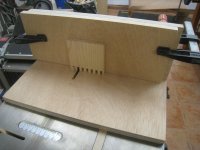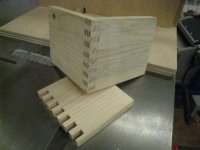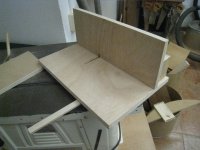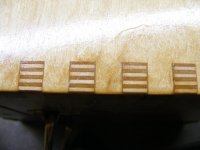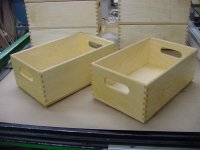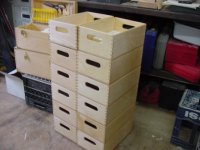I make most of my boxes to keep all of the pieces of a tool together with the main part of the tool, or whatever. Most of my boxes are never built any fancier than these, because they are "just tool boxes". The totes were made because I teach and demonstrate woodworking, mostly scroll sawing, so I needed a way to batch many small pieces, carry them around, and even move them from one workstation to another back in my shop. I built 12 of them a year ago, and I may be building another batch of them soon. They have proven to be very handy. Each has a 1" square piece of 9mm Baltic Birch with tapered sides glued to the tote bottom to act not only as feet, but also to locate each level of the stack by these feet fitting into the top of the tote below it. I have a Leigh D4R dovetail jig, but I rarely use it since I started making box joints so easily.
I understand your problem with European table saws and the European regulation prohibiting the use of DADO blade stacks in Europe, but would it be illegal to just stack two regular saw blades together? To me, this isn't really a DADO blade set, but you have to play by the rules. The box joint blade set that I use for 1/4 & 3/8" box joints is a Freud SBOX8, which is actually two identical saw blades, but they have offset teeth and a flat tooth ripping blade type of tooth grind. Orient them with the writing on them facing out and you cut 1/4" box joints. Orient them with the writing facing inward and they cut 3/8" wide box joints. The secret to clean flat bottomed cuts is that the saw blade teeth are flat top ground. the offset and long side of the teeth fit into the sawdust gullets of the mating blade so the center plates of the blades go together tightly. I also have a standard 10" Freud ripping blade that has 0.126" wide teeth, and although this blade is intended as a solid stock ripping blade, it actually cuts great, but small 1/8" box joints because it is also a flat tooth grind. For box joints larger than 3/8", I usually resort to my DADO blade set, and I know these are illegal for you to use. They scare me too.
Back to cutting box joints using a router table. The Incra I-Box jig is made to also be used on table saws, but yes I know, it has a 3/4 X 3/8" bar that needs to slide in an American sized table saw miter gauge slot that's 3/4 X 3/8", and it needs to fit this slot quite close, but I was thinking that this miter bar is actually just bolted to the bottom of the I-Box jig, so maybe it could be bolted to your saw's slider without using the bar. The setup instructions for the I-Box jig have you bolting this bar to the jig and squaring it with the fence part of the jig. You then slide the fence over to get the blade slot approximately in line with the blade, so the blade will then not touch the jig. You then use the adjustment knobs to move the jig's fingers over until the first finger just lightly touches a tooth of the non running saw blade or router bit. This calibrates the jig, and from there, when you change the adjustments for different box joint blade or bit widths, it also changes the spacing of the jig so the bit or blade cut both the slot and the mating fingers to the same settings. This part is automatic in the design of the jig, so changing from one size box joint to another only requires the one adjustment for the box joint slot width. The the pin width is then automatically adjusted to match the cut slot by the jig.
I'm just making suggestions and providing some thoughts toward future box joint making. You are farther along with your own shop made jig than I was when I first started making box joints. If you are happy with just one or two sizes of box joints, then why not just make a few jigs to do it, or get fancy and make one that is adjustable. I got into trouble when I decided that I needed to cut many sizes of box joints in different thicknesses of wood. This one desire caused me to create a huge pile of size specific jigs with one for every size. It was then that I created a space problem for myself and then need for an easily adjustable box joint jig.
Charley
